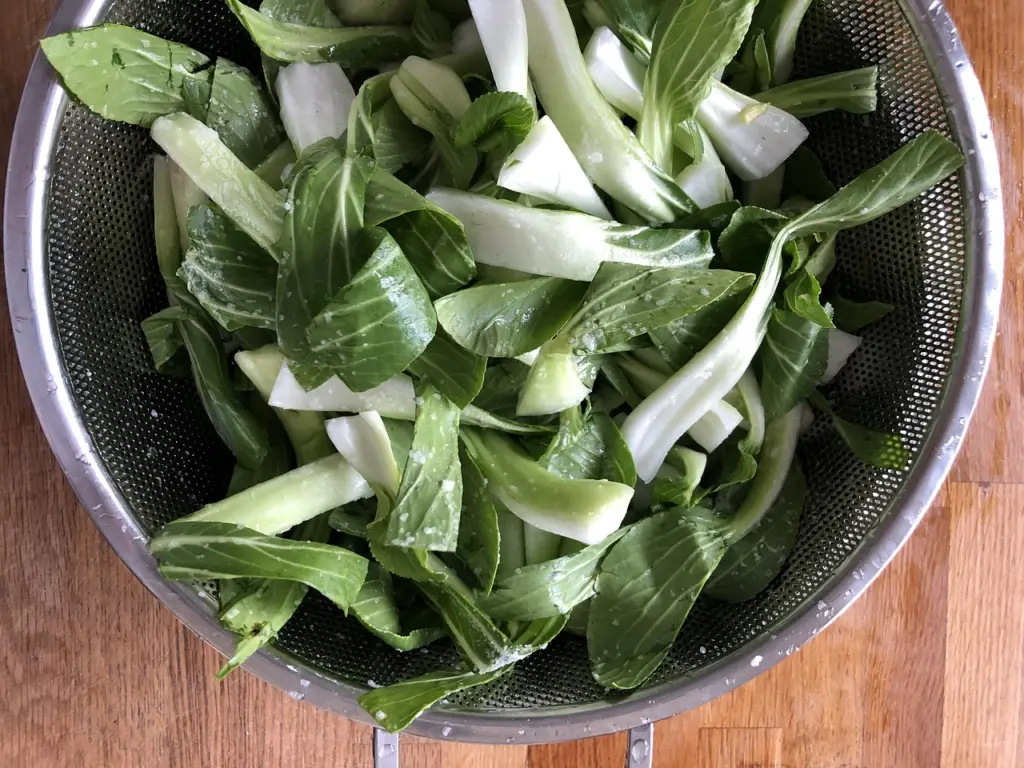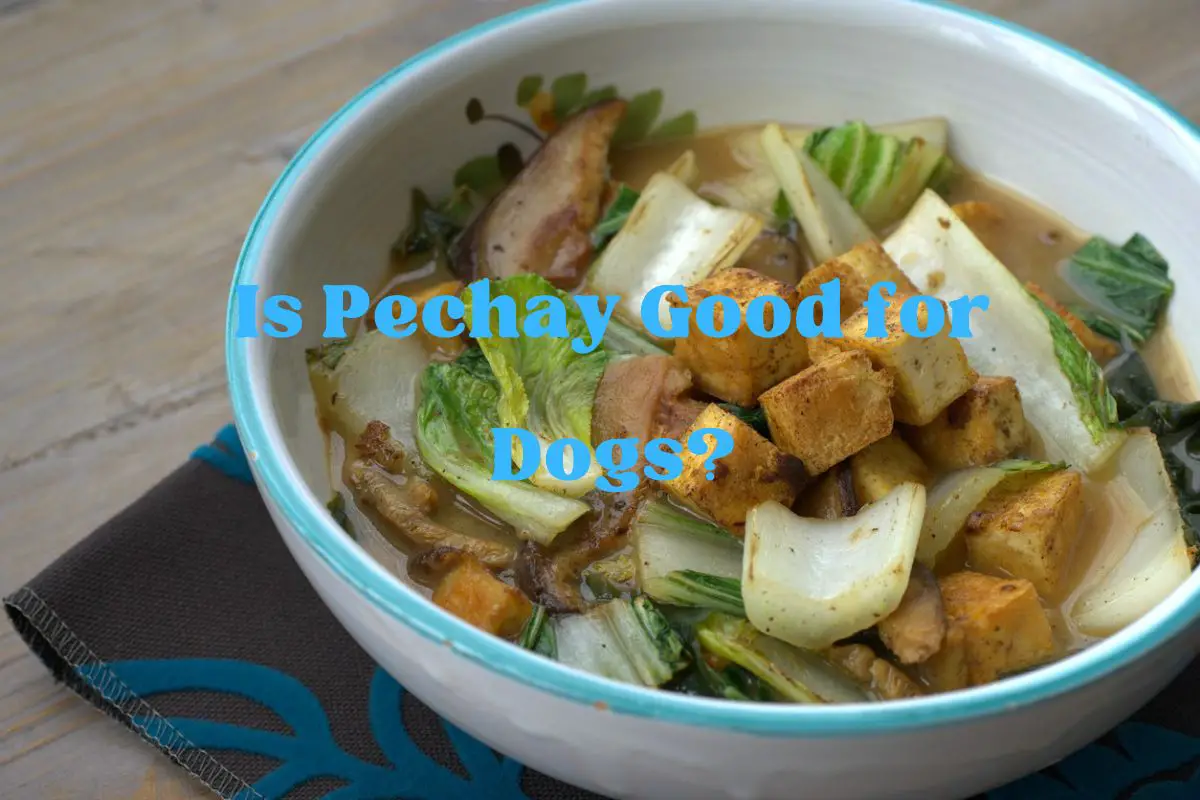Pechay, which you might hear called petsay or Chinese cabbage, or “bok-choy” in English, is a kind of dark green leafy veggie with thick, crunchy white parts. It’s been around since the 15th century in China, where people first used it because they believed it could help with health issues. These days, it’s really popular in many Asian dishes due to its great nutritional value and how versatile it is.
This veggie shares its family tree with super healthy foods like broccoli, cabbage, and kale, meaning it’s packed with good stuff like vitamins A, C, K, and a lot of fiber. It’s also got a mildly sweet taste and a satisfying crunch everyone loves.
So, this gets us to a big question: If pechay is such a hit for humans, is it alright for our dogs to enjoy it, too?
Is Pechay Good for Dogs?
Pechay can be a healthy addition to a dog’s diet. It’s typically safe and can contribute positively to their overall well-being, aiding in various bodily functions including ocular health, cardiovascular strength, digestive efficiency, and immune defense.
What is Pechay
Pechay, also known as bok choy or Chinese cabbage, is a delightful addition to many recipes from different parts of the world. Its crunchy white stalks and lush green leaves not only add a pop of color to the dinner plate but also introduce a wealth of versatility in taste and texture. This Asian-origin vegetable has earned its place in the hearts of food enthusiasts because it’s so rich in flavor and health rewards.
What Are the Health Benefits of Feeding it to Your Dog?
Feeding your dog pechay can indeed carry several health benefits. Being rich in vitamins and minerals, it presents itself as a nutritious addition to your dog’s diet. Here are some of the key benefits:
Supports Vision
Thanks to the abundance of vitamin A in pechay, this veggie can be an ally for your dog’s eyesight. Regularly dishing out pechay might just give their vision that little extra edge.
Promotes a Healthy Heart
With heart-friendly nutrients like folate and vitamin B6 in pechay’s profile, each bite helps in sustaining a healthy ticker. Plus, the magnesium and vitamin K content play a supporting role in keeping your dog’s heart pumping strong.
Aids in Digestion
If you’re looking for a natural way to keep your dog’s digestive track running smoothly, pechay’s high fiber content could be the answer. It’s especially helpful for pups who might struggle with slow-moving guts.
Strengthens the Immune System
Packed with vitamin C, pechay is like a little green shield, helping to bolster your dog’s immune defenses. This means they’re better equipped to wag off anything from the dog park cold to the sneaky sniffles.
Bone Health
Vitamin K, calcium, phosphorus – these are the unsung heroes in pechay that support strong bones. Young or old, every dog could use a little help keeping their skeleton sturdy and ready for adventure.
What is the Proper Way to Feed Pechay to Your Dog?

Considering adding some nutritious pechay to your canine friend’s diet? Here’s how you can incorporate it safely and effectively:
Go for a Thorough Wash
Start by cleaning the pechay under cool running water to get rid of any soil or debris. Once it is rinsed well, pat the leaves dry. This is an important step to ensure the vegetable is safe for consumption and to reduce the possibility of gastrointestinal upset for your pooch.
Focus on the Leaves
Most of the valuable nutrients that benefit your dog are found in the green leafy parts of the pechay. It’s usually best to take away the white stem, but don’t throw it away – it can be a fantastic addition to your homemade vegetable stock.
Serve It Raw or Steamed
To cater to your dog’s sensitive stomach, avoid cooking pechay with oil or seasonings as you would for yourself. Handing it over raw ensures that its full nutritional profile is intact. If you prefer providing a warm snack for those chillier days, you can lightly steam the pechay. Just be sure to let it cool off completely before you serve it to your dog.
The Right Size for a Safe Bite
Considering pechay’s crispiness, it’s important to slice it into small, easy-to-chew pieces to aid digestion. This is particularly important for puppies who might find it even more challenging to handle large pieces.
Introduce It Gradually
During snack time, present the pechay pieces slowly to your dog. Feeding small amounts incrementally is wise, as it not only helps prevent possible choking but allows you to watch how your dog reacts to this new addition to their dietary regimen.
Please Note:
The advice in this guide about introducing pechay to your dog’s meals is general in nature – remember that individual dogs might have varied reactions to different food types. It’s important to recognize that treats like pechay or other human foods should serve as an addition to, not a replacement for, a balanced diet designed for dogs.
Before trying out new foods such as pechay, it’s highly recommended that you seek advice from a vet or animal nutrition expert. They can provide input tailored to your dog’s breed, age, size, and general health status.
If your pet shows any negative symptoms, such as vomiting, diarrhea, or loss of appetite after eating, immediately stop providing the new food and get in touch with your vet. Your dog’s health and comfort should always be your foremost concern.

